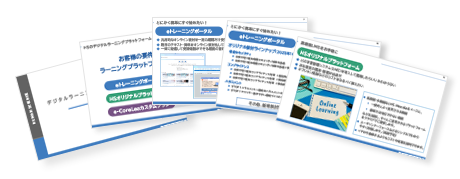2023.01.27
Moodle is not only used by universities (widespread use)
When you think of Moodle, you might have a strong image of it being used in universities. Indeed, the most common use in Japan is in universities. However, the impact of the COVID-19 pandemic has led to increased usage in various other settings. In this blog, we will introduce how and where Moodle is being used, particularly focusing on its applications outside of universities.

Table of Contents
1. What is Moodle?
2. Uses of Moodle
2-1. Use of Moodle in Universities
2-2. Use of Moodle in Elementary, Junior High, and High Schools
2-3. Use of Moodle in Vocational Schools
2-4. Use of Moodle in Companies
2-5. Use of Moodle in Public Organizations
3. Examples of Moodle Use Outside Universities
3-1. Hospital Organizations
3-2. Companies Providing Their Own Brand Products and Services in the Health Market
3-3. Companies Providing Comprehensive IT Solutions
4. Summary
4-1. What is Human Science?
4-2. Implementation Design
4-3. Operational Support
1. What is Moodle?
First, a brief introduction to Moodle. Moodle is a learning management system (LMS) equipped with features for supporting e-learning in face-to-face classes. It was developed in Australia and is distributed under the GNU General Public License. It is developed on a community basis. In Japan, it is widely used not only in universities and educational institutions focused on education but also by public organizations and companies. Here, we will introduce where Moodle is used overall and how it is being utilized.
2. Moodle is used for the following purposes
The places where Moodle is used can be classified as follows:
Universities, junior high and high schools, vocational schools, companies, public organizations
And each is used for purposes such as school classes, knowledge sharing, training, and certification.
2-1. About the Use of Moodle at University
(1) The Expansion of Moodle
Currently, the most utilized platform in Japan is at universities. It is only natural that universities are the best match, as the original concept of Moodle's development was to support face-to-face classes at universities. Moodle was already being used in universities before the spread of COVID-19. Relatively tech-savvy teachers introduced Moodle into their classes for distributing materials and conducting surveys. Subsequently, due to the impact of the pandemic, many cases emerged where its use expanded to entire faculties and then to entire universities. Initially, the teachers who launched Moodle managed it, but as the scale grew, the management tasks became unmanageable. I have heard that some teachers experienced several all-nighters to register new student users when the new semester began. Eventually, the operational tasks were transferred to the university's information systems department, and they began to request operational maintenance from official partner companies like ours. Thus, with the expansion of the pandemic, the introduction of Moodle spread across universities in Japan.
(2) Use of Teaching Materials and Assignments
There are various ways to use Moodle in universities. First, the simplest method is to post teaching materials for students to learn from, or to post assignments for them to submit reports on. If the files are Office files like Word, Excel, or PowerPoint, students can download them to their own computers to read. For PDFs, depending on the settings, they can be opened and read directly on Moodle. It is also possible to configure the settings to prevent downloading of PDF files. Regarding assignments, you can provide instructions for the assignment and have students upload their reports to Moodle by the deadline.
(3) Real-time Classes Using Web Conferencing
If you use a web conferencing system, you can watch the teacher's class in real-time with simultaneous interaction. In Moodle, by using a plugin to integrate with the web conferencing system, you can schedule and start meetings directly from Moodle. Until now, Zoom and Microsoft Teams have been commonly used. Recently, the use of the OSS BigBlueButton (https://bigbluebutton.org/) has been increasing. In Moodle 4.1, the BigBlueButton plugin is included as standard. Teachers and students can interact in real-time while learning.
(4) On-Demand Video Distribution
Teachers can view video materials created in advance from Moodle. It is also common to record real-time classes and post those videos. When using video materials, video files can be placed on Moodle (on the same server where Moodle is hosted), but if many students watch at the same time, stable video viewing can become difficult (it may take time to download the video). To avoid this, it is necessary to consider the number of students accessing simultaneously and the size of the video, and to enhance the specifications of the environment (server) where Moodle operates or to increase the network bandwidth. Recently, there has been an increase in the use of streaming services for comfortable video viewing. Streaming services like Millvi (provided by Ebily, https://millvi.jp/) and Vimeo (provided by Vimeo, https://vimeo.com/) have plugins available for Moodle, allowing for stable video viewing in conjunction with Moodle (additional costs may apply).
Another advantage of using streaming services is the ability to track viewing history in detail. It is a significant benefit to be able to check various histories, such as which videos are viewed the most during which time slots and what percentage of the target video each student has watched.
If video files are placed on Moodle, viewing history can also be obtained using a dedicated plugin for progressive download. Our company offers a video player plugin called "HS Video," which can record viewing status as an evaluation. In this case, there is no need for a monthly usage fee for using streaming services, resulting in significant cost benefits.
> Moodle Plugin Customization
(5) Knowledge Sharing
In addition to its use in classes, Moodle can also be used for knowledge sharing. Teachers create courses on specific themes. If they want to share information, they can post it in the course designated for that purpose. Information can be shared by uploading files such as PDFs or by posting URL links. By adding activities like chats or forums to the course, discussions about the posted information can take place, further enhancing knowledge sharing.
You can also see examples of Moodle implementation in schools in this article.
> Moodle Usage Rapidly Expands Due to COVID-19! The Latest Status of Classes and Training Using LMS
> [Moodle Basic Course] What Can You Do with the e-Learning Management System Moodle?
2-2. About the Use of Moodle in Elementary, Junior High, and High Schools
There is little information on the use of Moodle in elementary schools, but I would like to introduce one example. In one elementary school, there are about 30 computers in the computer lab, and classes are conducted using Moodle in a class of 25 students. It seems to be utilized in various subjects. Since they cannot spend much on costs, the free use of Moodle is very appreciated. However, there are various points that need improvement. In the case of elementary schools, there are still many materials in paper form, so it is necessary to consider how to electronically incorporate that paper into Moodle. One usage report mentioned that they use Moodle to share the results of their learning and learn from each other. The materials are scanned by the teacher and uploaded to Moodle as data. Students who view it on Moodle write comments on paper about what they felt, what they learned, and what they thought was good. The teacher scans that paper again, converts it into data, and uploads it to Moodle. Then, students learn by viewing the comments written by their classmates on Moodle. There is a need to consider ways to simplify the process of teachers scanning and uploading data to Moodle. The official Moodle site has forums for elementary, middle, and high schools where usage methods are discussed.
Reference: Moodle Forum for K-12
https://moodle.org/mod/forum/view.php?id=7704
Here is one example of how middle and high schools are utilizing technology. There have been reports of using the Moodle plugins STACK(※1) and WIRIS(※2) in mathematics classes. This was aimed at students connected to foreign countries, utilizing Moodle's quiz feature to conduct quizzes on kanji and Japanese, which helped enhance their motivation to learn.
(※1) STACK is an open-source system for computer-assisted assessment in mathematics and related fields, focusing on formative evaluation.
https://demo.tkita.net/moodledocs/35/ja/d665cf779f77b529385c9ca139883f45.html
(※2) WIRIS is a set of tools for mathematics education that integrates seamlessly with Moodle.
https://docs.moodle.org/3x/ja/WIRIS
2-3. About the Use of Moodle in Vocational Schools
In vocational schools, Moodle is used in various ways, such as distributing materials for students to read, conducting tests, and submitting reports. Additionally, students discuss with each other using the discussion feature and ask questions to teachers. It seems that things that are difficult to ask in person are easier to inquire about on Moodle, and I've heard that this has led to more active participation. Recently, schools have started to reopen, but we are able to communicate announcements from the school and messages from teachers using the bulletin board feature on Moodle.
2-4. About the Use of Moodle in Companies
Since the spread of the novel coronavirus, many companies have transitioned their internal training to online formats. In line with this trend, the use of Moodle has gradually expanded. In particular, Moodle is often used for company-wide training sessions on topics such as compliance, information management, and personal data protection. Additionally, it is utilized for various purposes, such as teaching sales staff how to sell their products and providing training materials for field workers to learn how to perform their tasks. Notably, video materials are frequently used for learning practical tasks. These videos capture actual work being performed, with added audio and subtitles. Videos related to safety education for safe work practices are also utilized.
Typically, the flow of general training involves several sessions per year, with a set duration, and targeted employees are required to participate. Employees read the materials uploaded to Moodle. After that, a quiz is conducted to check their understanding (whether they have read the materials properly). Completion of the training is achieved by obtaining a predetermined score. Administrators can check the training history and encourage employees who have not yet participated to complete the training.
You can also see case studies of Moodle implementation in companies in this article.
> Moodle Usage Rapidly Expands Due to COVID-19! The Latest Status of Classes and Training Using LMS
2-5. About the Use of Moodle in Public Organizations
(1) In the case of organizations related to obtaining qualifications,
the use of Moodle is progressing in various public organizations. Particularly for organizations related to obtaining qualifications, information necessary for qualification acquisition is first provided. While there is textual information, there are also quite a few video materials. Explanations by instructors or videos of medical procedures, if it is a medical qualification, may also be used. Additionally, past exam questions that were previously conducted are published and made available, and many practice test questions are also used. Preparing test questions each time is quite challenging, but Moodle's 'Question Bank' feature is very convenient. Once questions are created, they are continuously stocked in that question bank. Moodle allows for random questions to be drawn from there during tests. This is very effective when you want to repeatedly solve problems using past questions or practice questions.
(2) Knowledge Sharing in Medical Societies
Regarding medical societies, there is an increasing case of using Moodle for knowledge sharing by posting the latest information related to specific medical fields. Healthcare professionals such as doctors and nurses can obtain new information and insights about healthcare through Moodle. Hospitals are providing the necessary up-to-date information to healthcare professionals, including doctors and nurses, using Moodle. While a website would suffice for information disclosure, using Moodle allows tracking who accessed which information and how many accesses occur each month. This data can be utilized to update educational materials or replace them with content from different fields.
(3) Voting Function for Officer Election
In some organizations, it has been reported that the Moodle voting function is used to elect board officers. Typically, the process for electing officers involves a series of tasks that must be done manually, including announcing the candidates, voting, collecting the votes, tallying the results, and announcing the outcome. However, by using Moodle, this entire process can be conducted with minimal human intervention. Administrators can use Moodle's voting function to set the candidates as options and simply have people vote. Once the voting is completed, the results are tallied, so the outcome is known immediately. This voting function allows for both anonymous and named voting, and voters can choose to select one candidate or multiple candidates from the list.
(4) Identity Verification for Qualification Exams
Recently, there has been a lot of talk about wanting to conduct qualification exams using Moodle. To do this, identity verification is necessary. One current method is to take photos using the computer's camera at irregular intervals once the exam starts. These photos are automatically uploaded to Moodle, allowing the administrator to verify whether the person is actually taking the exam during the test. There can be a setting that requires the participant to agree to have their computer camera turned ON and photos taken to start the exam.
Although there have been no reports of implementation yet, there is also a service that uses AI to monitor whether participants are engaging in any cheating. This involves observing the participant's behavior. The AI analyzes details such as whether their eyes are darting around, whether they are frequently turning their face to the side, or whether they have been replaced by someone else. The AI can provide results indicating the percentage likelihood that this person is cheating. Among those who exceed a certain threshold, the administrator can review the actual footage (recorded for monitoring purposes) to confirm. If the practical examples using this AI increase and are proven to be reliable, it is expected that it will be adopted in many qualification exams.
3. Examples of Moodle Usage Outside of Universities
As mentioned at the beginning of this blog, Moodle is indeed the most widely used in universities. However, Moodle is also frequently utilized outside of universities. Here are three examples of its use outside of universities. Please consider whether it can be utilized in your own context.
3-1. Hospital Organization
A certain municipal hospital organization has established an e-learning site using Moodle. The number of registered users is approximately 6,000 staff members within the organization, and the server utilizes cloud services. The operation of Moodle is managed by the internal staff themselves. Due to the impact of the COVID-19 pandemic, in-person training became impossible, which was a challenge, but the Information Promotion Department introduced and launched Moodle. The training covers general topics such as information security and compliance, as well as content specialized for the hospital organization. The teaching materials include recordings of training conducted via Zoom, which are stored on a streaming server within the organization and distributed through Moodle. After the learning sessions, a confirmation test is conducted, and upon course completion, badges are awarded to help maintain motivation. Additionally, there are mandatory trainings that must be completed, so the attendance of individuals for these required trainings is managed using Moodle.
3-2. Companies that offer their own branded products and services in the health market
This company uses Moodle on-premises for security training. The number of users is close to 1,000, including group companies. Internal training is conducted 2 to 3 times a year across the company, and training for new employees is held about once a month for around 10 people. They create and operate their own video and text materials. The videos are designed to be embedded in the Moodle interface. In addition to training materials, they also upload recordings of company-wide events, which can last up to 2 to 3 hours. This is temporary, and they delete it after a certain period due to the large file size (it was mentioned that not many people watch it because of the long duration). They control the video materials to prevent downloads, as they do not want them to be saved. Additionally, each course includes a quiz, and participants are required to take the test after watching the videos. There are about 10 questions in the quiz.
3-3. A company that provides comprehensive IT solutions
The purpose of using Moodle is employee training, including initial education for newly hired employees. Initially, it was used by only one department, but it has since expanded to other departments and is now used company-wide. There are approximately 2,000 users. Moodle is built and operated on a rental server. In the future, we plan to integrate it with Zoom and Microsoft Teams. Additionally, there are requests to accommodate personnel transfers and department changes in detail, as well as to use the learning progress of participants for performance evaluations.
You can also see case studies of Moodle implementation in companies in this article.
> Moodle Usage Rapidly Expands Due to COVID-19! The Latest Status of Classes and Training Using LMS
> Moodle Implementation and Operation Support Achievements
4. Summary
Currently, Moodle has expanded beyond its original development concept of "supporting university classes" and is being used in various places. For readers considering the introduction of an online learning system, there may be some who are unsure how Moodle can meet their needs. To build your own original online learning system using Moodle's rich features, we recommend seeking the assistance of an official Moodle partner.
There are several official Moodle partners in Japan, and this time we would like to introduce Human Science Co., Ltd., which has a wealth of experience.
4-1. What is Human Science</h>
Human Science became an official Moodle partner in 2017, certified by the Moodle headquarters in Australia. Only companies with expertise and proven results in building and operating Moodle are certified. While certified companies exist worldwide, there are only a few in Japan.
Leveraging the know-how and the number one domestic operational track record (projects: over 700, companies, schools, and organizations: over 80 cases), we provide total solutions from Moodle implementation to operational support.
Next, we will explain the services provided by Human Science step by step.
4-2. Implementation Design
<Client Situation Hearing and Proposal>
We provide support for Moodle configuration to realize the educational flow that our clients want to implement.
Moodle has a wealth of features, so we will make it user-friendly for learners by anticipating how it will be used. The configuration of Moodle allows you to show/hide features.
・Requirements Definition
We will hear what our clients want to achieve with the introduction of e-learning and refine the specifications.
・Support for Building E-Learning Operational Business Processes
E-learning operations involve various tasks such as course registration, communication with users, distribution, and effectiveness measurement. We will assist in building the business flow to ensure successful implementation and operation.
・Demo Site Construction
We will set up a demo site, allowing clients to confirm the actual operation of Moodle while tuning the settings and features.
> Moodle Implementation Support and Operation
<Moodle Construction>
We will install Moodle and make it ready for use.
We can build it on-premises (owned and operated by your company) as well as on cloud platforms like AWS and Azure.
We also perform replacements from existing systems you are using to Moodle.
・Selection of hardware specifications
Determined by the number of users and how it will be used.
・Installation of middleware
We will install open-source middleware such as apache (Nginx), php (php-fpm), and postgresql.
・Installation of Moodle
・Configuration of Moodle
We will configure Moodle based on the expected usage.
・Customization and plugin development
We will carry out customization and plugin development for features that are difficult to achieve with Moodle's standard functions.
> Moodle Construction
> Moodle Plugin Customization
We also offer a cloud service called e-CoreLea.
You can use an environment where Moodle is already installed and set up, so there is no need for customers to prepare or build servers, networks, or perform installation and initial configuration.
We also have video distribution plans and plans that include educational content. Please contact us for more details.
> Moodle Cloud Service (e-CoreLea)
4-3. Operational Support
<Usage Seminar>
We will hold a seminar on the basic usage of Moodle.
It is expected to be in a lecture format using a web conferencing system (such as Zoom) for about 5 hours a day. The content will include preparation, user registration, course registration, quiz creation, downloading grades, and creating surveys.
<Operation Manual>
We provide a tutorial manual on how to use Moodle.
> Moodle Implementation, Seminars, Manuals
<Regular Maintenance (Version Upgrade)>
Moodle has many versions.
Human Science supports version upgrades.
> Moodle Version Upgrade
<Inquiry Support>
We provide support services for Moodle via phone and email.
The biggest advantage of Moodle is that it is open source and free, but maintenance and operation are the user's responsibility.
The main contents include the following:
・Phone and email support for inquiries regarding Moodle operations
・Delivery of a monthly report summarizing the inquiries
・Investigation of the causes of Moodle bugs (fixes are separate)
*In addition to support for Moodle operations and management, we also provide regular maintenance such as frequent Moodle updates, server environment upgrades, and new information about new features.
> Moodle Maintenance and Operations
> Frequently Asked Questions about Moodle Implementation and Operations Support
From the above, it is clear that Human Science provides support from the introduction to the operation of Moodle. For those who want to know more details, you can obtain materials from the link below.
Introduction to Moodle Implementation Support Services | Case Studies and Useful Material Downloads | Over 2,693 Achievements by Human Science (hs-learning.jp)
Human Science offers a variety of services to help our clients implement and operate e-learning.
If you have any concerns, please feel free to contact us.
> e-learning material production
> e-learning material translation
> in-house material support
> Articulate Storyline, Studio implementation support and creation agency services
> microlearning implementation support
> Flash to HTML5 migration and conversion
> Moodle and Totara Learn (open-source LMS) implementation and operational support
For the contact form, click here(https://hs-learning.jp/contact/)
Moodle Implementation and Operation Guide

We explain the process of introducing and operating Moodle.
For the introduction and operation of Moodle, please leave it to Human Science, the official partner. We also introduce many achievements in Moodle implementation support.
Projects: Over 866
Companies, Schools, Organizations: Over 80 cases
Moodle Related Information
- 2025.07.02
- [Moodle Manual ①] 2025 Edition|How to Set Assignments & Tips for Use Explained by Support Staff!












